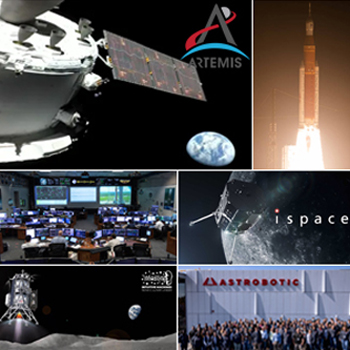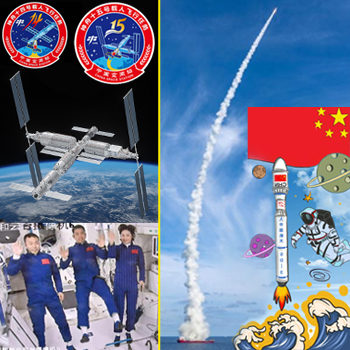“We Are Going” Says NASA as Artemis 1 Spacecraft Nears Moon – ispace, Astrobotic and Intuitive Machines to Follow
The Orion crew capsule, powered by European Service Module, is on course to flyby Moon on November 21. As Orion makes 100-km Moon approach, a gravity assist maneuver to achieve lunar orbit will be implemented by 195 m/s ∆v firing, followed by 149 m/s ∆v burn on Nov 25 to enter 100 x 70,000 km Distant Retrograde Orbit. Meanwhile, 7/10 6U science CubeSats deployed from ICPS / Orion Stage Adapter also are making their way to various cislunar and heliocentric destinations in nominal fashion including ArgoMoon, BioSentinel, CuSP, EQUULEUS, LunaH-Map, Lunar IceCube, LunIR. NEA Scout and Team Miles are not communicating, and the OMOTENASHI team is working to restore control. ispace HAKUTO-R Mission 1, a Japan-based commercial effort, is also to send a lander from KSC to the Moon Nov 28, launching on a SpaceX Falcon 9 along with Lunar Flashlight on a 4-month low-energy trajectory. ispace M1 lander will descend to basaltic plain Mare Frigoris (Sea of Cold) while Lunar Flashlight will enter 14 x 68,000 km orbit. Astrobotic is working towards Q1 2023 launch to Moon, with Peregrine lander shipped from its Pittsburgh HQ for thermal vacuum, acoustic, vibration and electrostatic testing in preparation of integration with ULA Vulcan Centaur. Fellow CLPS provider Intuitive Machines of Houston is striving for a similar launch window for Nova-C lander, making for a competitive race for the first USA landing since Apollo 17 / first ever commercial USA landing. (Image Credits: NASA, ispace, Astrobotic) |
MONDAY☆ Nov 21 — ISS, ~415-km LEO: Expedition 68 seven-member crew prepare for Dragon CRS-26 cargo arrival, continue EMU and Orlan spacesuit upkeep for USA & Russia EVAs (possibly 5 additional before 2023) for radiator and solar array work. ☆ Nov 21 — Tiangong Space Station, ~390-km LEO: Shenzhou 14 three-member crew prepare for Shenzhou 15 crew arrival, working with Tianzhou-5 cargo including 1-kg of grain seeds intended for return to / sale on Earth. Highlights… o NewSpace: Space Perspective plans near-space voyages from off-shore MS Voyager platform, test flights NET early 2023, commercial flights in late 2024; Sierra Space progresses toward 2023 Dream Chaser launch to ISS with newly fitted panels; Virgin Orbit preparing for 1st launch from UK at Spaceport Cornwall this year. ☆ Solar System: Capstone team working to execute 2 minor correction maneuvers, fine-tuning NRHO planned for Gateway; Danuri en route to Moon, advancing space communications following K-pop music transmission from 1,210,000 km distance; to keep Psyche on track for 2023 launch, JPL shifts Venus VERITAS to 2031. ☆ Galaxy: IXPE observation of magnetar 4U 0142+6, 13,000 LY distant from Earth, characterizes object as solid and without atmosphere; Rice University supercomputer simulations suggest ‘radius valley’ between exoplanets 1.4x – 2.4x Earth radii caused by planetary migration. o Global: CSA-ASC to operate water-seeking lunar rover with lunar night survivability built by Canadensys with PI Gordon Osinski NET 2026; Blue Origin courting prospective space tourists in Dubai; BlueWalker 3 satellite with 54m2 communications array (1st in planned 168 constellation) may interfere with optical & radio astronomy per IAU and NRAO. ● USA: Public awaiting announcement of Artemis 2 crew for May 2024 after successful Artemis 1 launch; SpaceX to further develop Starship for sustained human lunar landings including Artemis 4 NET 2027 under ‘Option B’ US$1.15B contract modification; Military contracts prompt employee resignations at Terran Orbital. ● Hawai’i: Astronomy professor Pierre Martin proposes half of observing time at future teaching telescope at Halepohaku be offered to public; Starship to undergo 2 more static fire tests prior to NET Dec orbital test launch ending in Pacific ~100 km NW offshore of Kauai. |
 |
● = Terrestrial and… o = International terrestrial events
☾ = Moon activity ★ = Space and… ☆ = International space / astro events in Hawaii Standard Time unless noted. Add 10 hours to obtain UT (‘Universal Time’). |
Weekly Planet Watch – Evening Planets: Mars (ENE), Jupiter (S), Saturn (S), Uranus (E), Neptune (SE).
China Advances Sea Launch with Inaugural Jielong 3 Flight, and Expanding Occupation of Tiangong to 6 with Upcoming Shenzhou 15 Crew
The first Jielong 3 (Smart Dragon 3) sea launch from the Yellow Sea (near 35°N, 122°E) is set for November 27 by China National Space Administration. Developed by China Academy of Launch Vehicle Technology, the 4-stage solid fuel rocket is capable of lofting 1,500 kg to 500 km SSO. This flight, possibly from new Haifa (海发号) vessel or the previously-utilized Tai Rui, will carry multiple satellites including Chinese Amateur Radio Satellites CAS-5A (a 6U nanosatellite) which will deploy the 0.5-kg CAS-5B. This will be the 5th sea launch attempted by China, leaving ‘Dongfang space port’ from Haiyang Port in eastern coastal province Shandong. As early as November 29, the Shenzhou 15 crew comprised of 3 Taikonauts from People’s Liberation Army Astronaut Corps (Chinese Astronaut Corps) will launch to Tiangong Space Station at ~390-km from Jiuquan Launch Center on a Chang Zheng (Long March) 2F rocket for the nation’s 10th crewed space mission. Their 6-month mission will be the first to overlap with another crew, Shenzhou-14, marking the first sequence for continuous occupation of TSS. Tianhe core module is now in its final T-shape configuration with Wentian and Mengtian laboratory modules, and has Tianzhou 5 cargo ship attached. The Xuntian ‘Space Sentinel’ telescope is planned to launch December 2023 to co-orbit with TSS allowing it to periodically dock. (Image Credits: Xinhua, CASC, CNSA, CMSA) |
☾ Nov 21 — Orion, Circumlunar Trajectory: Orion Uncrewed Multi-Purpose Crew Vehicle and ESA Service Module on Artemis 1 mission first closest approach of Moon today ~100-km with Outbound Powered Flyby; live coverage 07:15 EST available.
★ Nov 21 — SpaceX, Launch Falcon 9 / Dragon CRS 26, Kennedy Space Center, LC-39A: Falcon 9 to launch 26th Commercial Resupply Services Dragon capsule to ISS; final of 6 additional cargo missions NASA awarded in 2015 to SpaceX under CRS-2 contract. ● Nov 21 — National Space Council, Online / Washington DC: Listening Session Part 2: In-Space Authorization and Supervision Policy: Approaches to Authorization & Supervision; 13:00-15:00 EST. o Nov 21-25 — International Space University, E&I Korea, KARI, KASI, MSIT, KOFST, et al, Seoul, S Korea: ISU Executive Space Course 2022; featuring Pascale Ehrenfreund, Bernard Foing, Virginia Wotring, Tai Sik Lee, more. ☆ Nov 21 — Jupiter: 6.1° ENE of Neptune, 17:00. ☆ Nov 21 — Aten Asteroid 2019 OR1: Near-Earth Flyby (0.046 AU) ☆ Nov 21 — Aten Asteroid 2019 VA4: Near-Earth Flyby (0.066 AU) Continued From… ☾ Aug 4 – Dec 16 — Korea Pathfinder Lunar Orbiter (KPLO), Lunar Trajectory: South Korea ‘Danuri’ to search for lunar resources & test technologies; performing 3 highly elliptical Earth orbits to initiate a trans-lunar injection and arrive at 100-km lunar orbit. ● Oct 29 – Dec 31 — Canada-France-Hawaii Telescope, W.M. Keck Observatory, Maunakea Observatories, Kamuela HI: Waimea Solar System Walk for 2022; combining in-person and self guided walks, along Ala ‘Ōhi’a Road. ● Nov 14 – Jan 17, 2023 — Wichita State University, Wichita KS and Online: Registration Open for 2023 Interstellar Seminar ‘LASI 150G’; 1-credit hour seminar which begins Jan 17, every Wednesday 14:30-15:20, led by Prof. Mark Schneegurt. o Nov 16-25 — National Space Foundation, NOIRLab, International Dark-Sky Association, AURA, Online / Global: Globe at Night November Campaign; campaign to raise awareness of light pollution by inviting citizen-scientists to measure & submit night sky brightness observations (goal 20,000 data points for 2022). |
TUESDAY
o Nov 22-23 — ESA, Paris, France: ESA Council Ministerial Meeting 2022 (CM22); European Space Agency 22-member nations meet to set upcoming policy.
o Nov 22-23 — Space Industry Association of Australia (SIAA), Canberra, Australia: Southern Space Conference.
☆ Nov 22 — Apollo Asteroid 2022 VS1: Near-Earth Flyby (0.016 AU)
WEDNESDAY
☆ Nov 23 — ISS, Dragon CRS 26 Rendezvous and Docking, ~415-km LEO: SpaceX 26th Commercial Resupply Services Dragon capsule to dock at ISS, live coverage available, 09:43 EST.
☆ Nov 23 — Arianespace, Launch Vega-C / Pléiades Neo 5 & 6, Kourou, French Guiana: Arianespace Vega-C rocket to launch Pléiades Neo 5 and 6 Earth observation satellites for Airbus.
☆ Nov 23 — Moon: New Moon, 12:56.
☆ Nov 23 — Mercury: 3.1° NNE of Antares, 13:00.
☆ Nov 23 — Apollo Asteroid 2005 LW3: Near-Earth Flyby (0.007 AU)
☆ Nov 23 — Aten Asteroid 2019 WJ: Near-Earth Flyby (0.067 AU)
THURSDAY
☆ Nov 24 — Moon: with Mercury and Venus within circle of diameter 2.27°, 03:00; 2.21° NNE of Antares, 04:00, 2.27° S of Venus, 04:00; 0.92° S of Mercury, 05:00.
☆ Nov 24 — Venus: 4.5° N of Antares, 00:00.
☆ Nov 24 — Apollo Asteroid 2022 UG1: Near-Earth Flyby (0.072 AU)
FRIDAY
☆ Nov 25 — ISS, Russian EVA #56, ~415-km LEO: 7-hour Russia spacewalk 56 planned to relocate a radiator from Rassvet module to Nauka multipurpose laboratory; live coverage available, starts 06:15 EST.
☾ Nov 25 — Orion, Distant Retrograde Orbit Insertion: Orion Uncrewed Multi-Purpose Crew Vehicle and ESA Service Module on Artemis 1 mission will attempt to achieve DRO insertion today, remain in DRO for ~6 days.
☆ Nov 25 — Moon: At perigee (distance 362,789 km), 15:37.
☆ Nov 25 — Apollo Asteroid 2022 UA34: Near-Earth Flyby (0.058 AU)
☆ Nov 25 — Aten Asteroid 2021 WA1: Near-Earth Flyby (0.060 AU)
SATURDAY
★ Nov 26 — InSight, Elysium Planitia, Mars Surface: Interior Exploration using Seismic Investigations, Geodesy and Heat Transport (InSight) lander reaches 4 full years / enters 5th year on Mars today; continues investigations with seismometer, heat probe, radio science experiments; already extended through December 2022 mission could be extended further.
o Nov 26 — British Interplanetary Society, London, United Kingdom and Online: Space Domain Awareness and Exoplanets; with Professor Don Pollacco.
SUNDAY
☆ Nov 27 — CNSA, Launch Jielong-3 / CAS-5A & CAS 5B, Off-shore Platform, Yellow Sea, China: First launch of Jielong-3 (Smart Dragon 3) solid rocket booster from floating vessel Tai Rui in the Yellow Sea; to loft Chinese Amateur Radio Satellites: 6U CAS-5A nanosatellite which will deploy CAS-5B weighing 0.5 kg; other satellites including Huoju-1.
☆ Nov 27 — Apollo Asteroid 2022 VQ: Near-Earth Flyby (0.019 AU)

